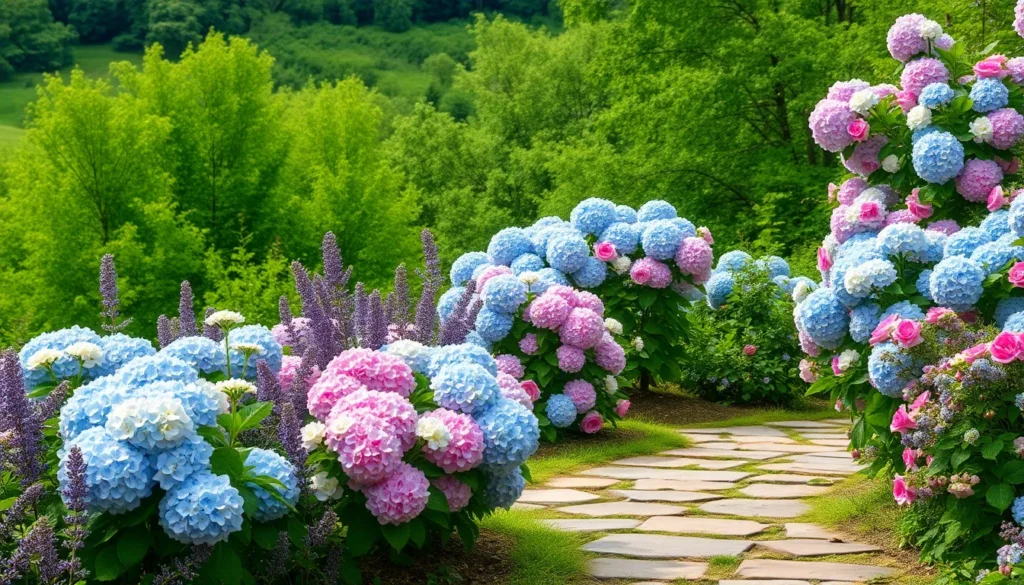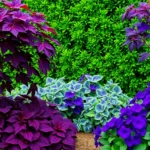We’ve all fallen in love with hydrangeas at some point – those stunning, cloud-like blooms that transform any garden into a dreamy paradise. Whether you’re drawn to their vibrant blues, soft pinks, or classic whites, these versatile flowers offer endless possibilities for creating breathtaking outdoor spaces.
Hydrangeas aren’t just beautiful; they’re surprisingly adaptable. From compact container gardens perfect for small patios to sprawling industry designs that make neighbors stop and stare, we’ll show you how to harness their full potential. These flowering powerhouses thrive in various conditions and pair beautifully with countless other plants.
Ready to transform your garden into a hydrangea haven? We’re about to jump into creative ideas that’ll help you design stunning displays, choose the perfect varieties for your space, and create year-round interest that keeps your garden looking spectacular. Let’s explore how these magnificent blooms can become the stars of your outdoor sanctuary.
Create a Classic Cottage Garden With Mixed Hydrangea Varieties
Cottage gardens blend informal charm with abundant blooms, and hydrangeas serve as perfect anchor plants for this timeless garden style. We’ll show you how to create a romantic, English-inspired industry that combines multiple hydrangea varieties with traditional cottage garden companions.
Choose Complementary Hydrangea Types for Year-Round Interest
Bigleaf hydrangeas form the foundation of our cottage garden design with their large, showy blooms in pink, blue, and white. These classic varieties like ‘Endless Summer’ and ‘Nikko Blue’ provide the dramatic focal points that cottage gardens are known for.
Panicle hydrangeas extend our blooming season from midsummer through fall with their cone-shaped flower clusters. We recommend ‘Limelight’ and ‘Little Lime’ for their reliable performance and stunning color transitions from green to pink.
Oakleaf hydrangeas contribute exceptional fall foliage interest with their burgundy and orange autumn colors. Varieties such as ‘Alice’ and ‘Ruby Slippers’ offer both beautiful white blooms and four-season appeal that cottage gardens require.
Smooth hydrangeas complete our mixed planting scheme with their pure white, round flower heads. ‘Annabelle’ and ‘Incrediball’ provide reliable blooms and work exceptionally well in partial shade areas of the cottage garden.
Incorporate Traditional Cottage Garden Plants as Companions
Roses pair beautifully with hydrangeas, creating the quintessential cottage garden romance. We suggest planting climbing roses like ‘Eden’ or ‘New Dawn’ behind hydrangeas to provide vertical interest and complementary bloom colors.
Lavender offers aromatic foliage and purple spikes that contrast perfectly with hydrangea’s rounded blooms. Plant English lavender varieties such as ‘Hidcote’ or ‘Munstead’ along pathways for both fragrance and visual appeal.
Delphiniums provide tall, spiky flowers in blues and purples that echo hydrangea colors while adding height variation. These perennials work particularly well behind shorter hydrangea varieties to create layered plantings.
Catmint serves as an excellent ground cover companion with its gray-green foliage and small blue flowers. Varieties like ‘Walker’s Low’ and ‘Six Hills Giant’ bloom repeatedly throughout the season and complement hydrangea’s bold textures.
Foxgloves contribute vertical elements and cottage garden authenticity with their tall flower spikes. We recommend common foxglove (Digitalis purpurea) in white, pink, and purple shades that harmonize with hydrangea blooms.
Lady’s mantle provides soft, chartreuse flowers and distinctive pleated foliage that contrasts beautifully with hydrangea’s bold leaves. This perennial thrives in similar growing conditions and creates a cohesive cottage garden aesthetic.
Design a Stunning Hydrangea Border Along Your Property Line
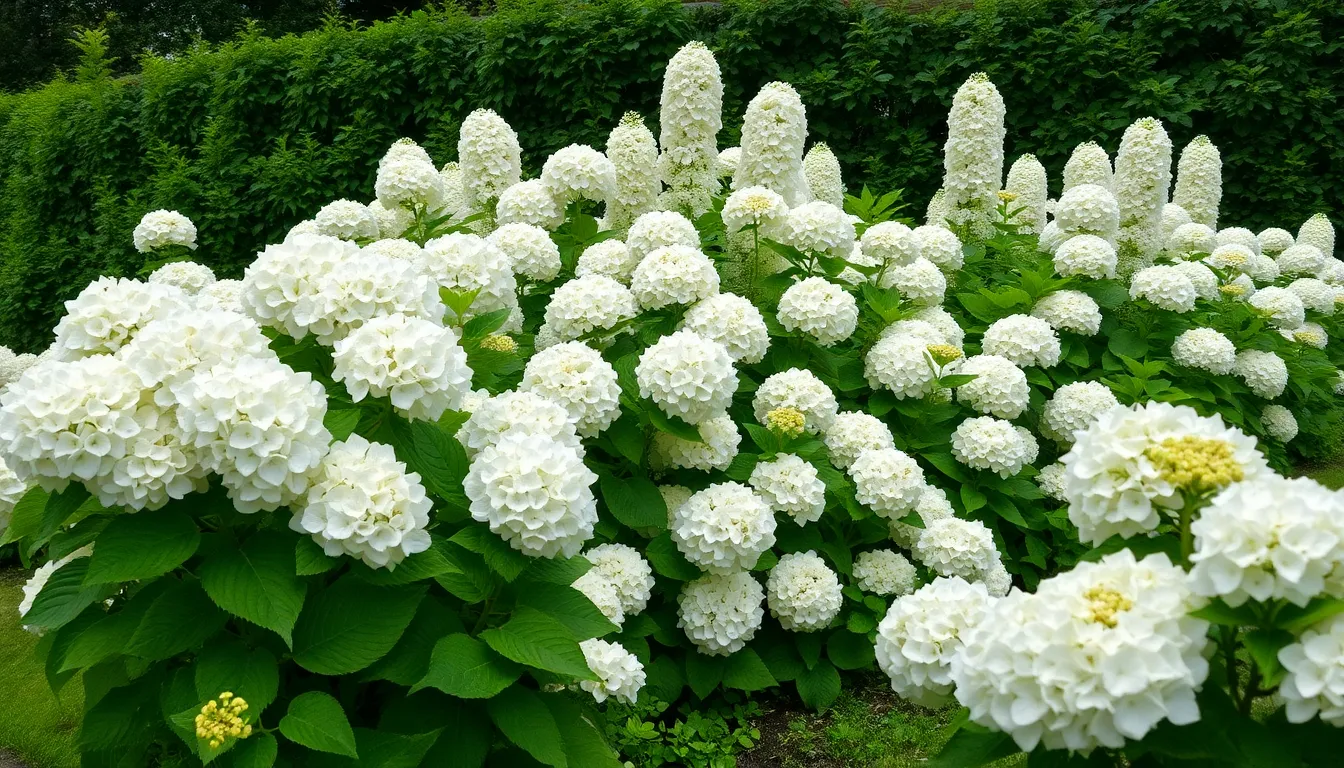
Creating an elegant hydrangea border transforms your property line into a natural privacy screen while adding spectacular seasonal color. We’ll explore strategic planting techniques that maximize visual impact while establishing clear boundaries for your outdoor space.
Select the Right Hydrangea Heights for Layered Screening
Choose varieties based on their mature heights to create a dramatic tiered effect along your property line. Bigleaf hydrangeas typically reach 3-5 feet, making them perfect for front layer placement, while panicle hydrangeas can soar to 8-15 feet for stunning background screening.
Plant taller hydrangeas towards the back of your border to establish the primary privacy barrier. Panicle varieties like ‘Limelight’ and ‘Little Lime’ provide excellent height variation, with ‘Limelight’ reaching up to 8 feet and ‘Little Lime’ staying compact at 3-5 feet.
Position shorter varieties in the foreground to create visual depth and accessibility for maintenance. Smooth hydrangeas such as ‘Annabelle’ work beautifully as front border plants, offering 3-5 foot heights with massive white blooms that brighten the entire display.
Layer oakleaf hydrangeas in the middle section for transitional height and unique foliage texture. These varieties typically grow 4-6 feet tall and provide exceptional fall color that extends your border’s seasonal interest beyond the blooming period.
Plan Seasonal Color Transitions for Maximum Impact
Start with early spring companions like azaleas or tulips to provide color before your hydrangeas begin their show. These spring bloomers create anticipation and maintain visual interest during hydrangeas’ dormant period, ensuring your border remains attractive year round.
Transition into summer when hydrangeas take center stage with their spectacular blooms from late spring through early fall. Mass plantings of single varieties create bold color statements, while mixed plantings with roses, hostas, or ferns add textural complexity and extended blooming periods.
Extend into autumn by incorporating asters or chrysanthemums that bloom as hydrangea flowers begin to fade. These fall companions maintain vibrant color while hydrangea foliage transforms into brilliant reds, oranges, and purples for a stunning seasonal finale.
Maintain winter interest by adding evergreen shrubs or ornamental grasses throughout your hydrangea border. These structural elements provide visual weight and movement during dormant months, while dried hydrangea blooms offer architectural beauty against winter’s stark industry.
Build a Shade Garden Paradise With Hydrangeas as Focal Points
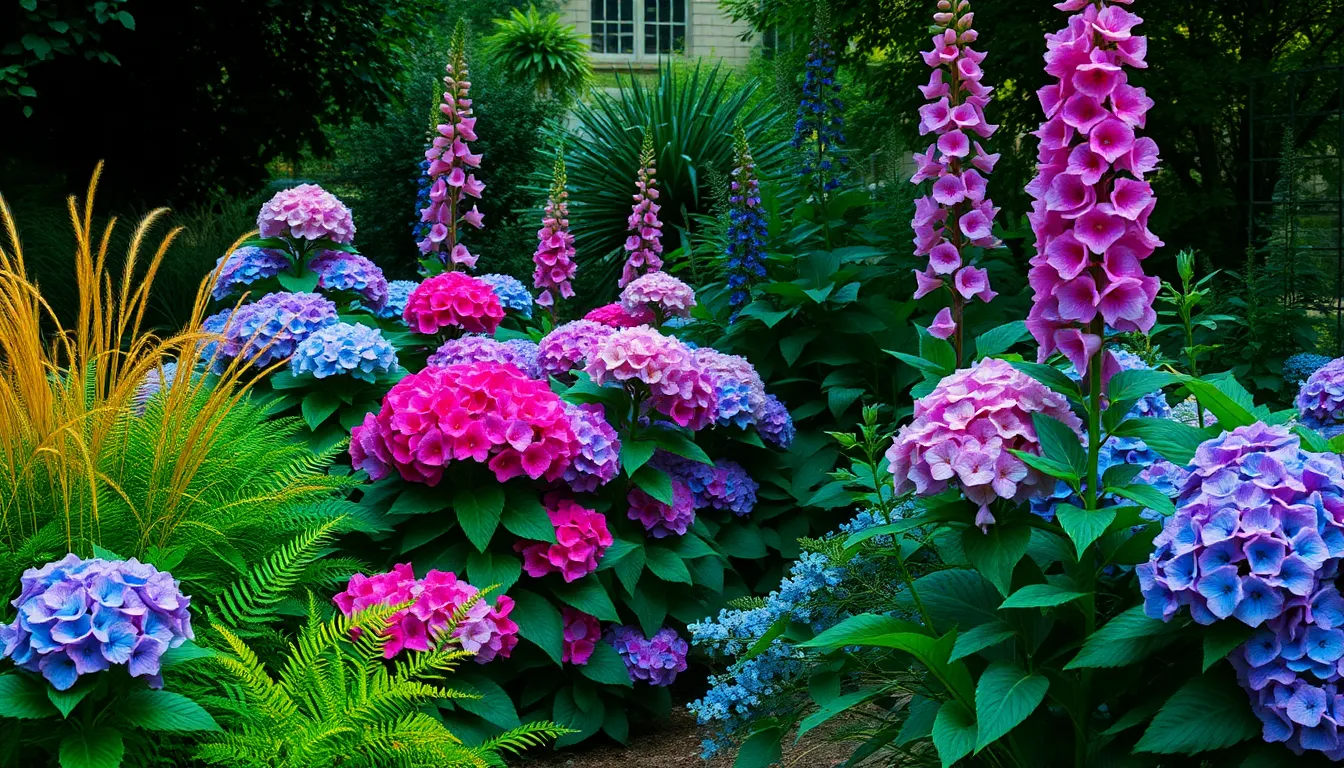
Creating a stunning shade garden doesn’t mean sacrificing vibrant blooms and visual interest. We can transform those darker areas of our industry into thriving garden sanctuaries by strategically positioning hydrangeas as our centerpiece plants.
Position Hydrangeas to Brighten Dark Garden Corners
Hydrangeas excel at transforming forgotten shadowy spaces into colorful garden retreats. We’ll plant them in areas that receive gentle morning sunlight followed by afternoon shade to maintain their spectacular bloom display throughout the season.
Dark corners become instant focal points when we position hydrangeas in strategic groupings. Mass plantings create dramatic impact while single specimens work beautifully in containers for flexible placement options. Border arrangements along shaded walkways or under tree canopies add structure and seasonal color to previously underutilized spaces.
Morning sun exposure helps hydrangeas develop their full color potential while afternoon shade protects delicate petals from harsh heat stress. We can maximize their brightening effect by choosing varieties with white or light colored blooms that naturally reflect available light in darker garden areas.
Add Shade-Loving Perennials for Textural Contrast
Foxglove creates stunning vertical drama when paired with hydrangeas’ rounded shrub forms. These perennials produce elegant spiky flowers in white, pink, and lavender shades that complement hydrangea blooms while adding essential height variation to our shade garden design.
Hakone grass brings golden warmth to shadowy garden spaces with its graceful mounding habit and distinctive strappy foliage. This ornamental grass creates beautiful textural contrast against hydrangeas’ broad leaves while providing year round visual interest even after flowers fade.
Additional companion plants enhance our shade paradise through diverse textures and forms:
- Hostas contribute bold foliage patterns and subtle flower spikes
- Astilbe offers feathery plume flowers in complementary colors
- Ferns provide delicate fronds that soften harsh garden edges
We can also incorporate roses and lilacs alongside our hydrangeas to create diverse bloom sequences that extend flowering periods throughout summer months. This combination approach ensures our shade garden maintains continuous color and visual appeal while requiring minimal maintenance once established.
Establish a Low-Maintenance Hydrangea Foundation Planting
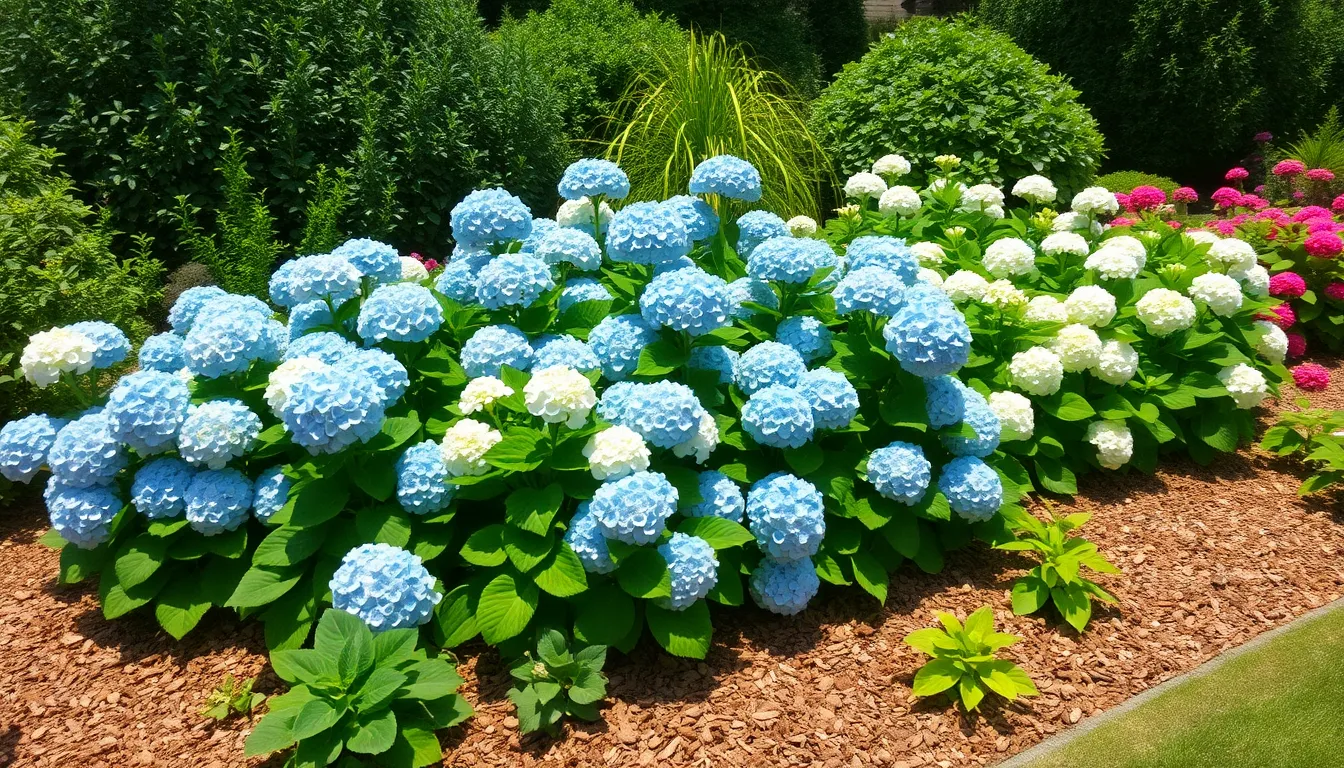
Building upon our shade garden paradise, we’ll create a sturdy foundation that requires minimal upkeep while delivering maximum visual impact. Foundation plantings serve as the backbone of successful hydrangea gardens.
Choose Disease-Resistant Varieties for Easy Care
Panicle hydrangeas stand out as the most resilient choice for foundation plantings, offering superior disease resistance compared to other hydrangea types. These hardy performers include varieties like ‘Limelight’ that maintain their strength throughout challenging growing seasons.
Oakleaf hydrangeas provide exceptional hardiness and natural disease resistance, making them perfect candidates for low maintenance gardens. Their robust nature means we spend less time treating problems and more time enjoying beautiful blooms.
Bigleaf hydrangeas require careful selection since they’re more susceptible to disease issues. We recommend choosing improved varieties like ‘Twist-n-Shout’ and ‘Endless Summer’ that offer better resistance while still delivering the classic hydrangea appeal we love.
Smooth hydrangeas complement our foundation plantings with their reliable performance and minimal care requirements. These native varieties adapt well to various conditions and rarely encounter serious disease problems.
Design Mulching Strategies to Retain Moisture
Organic mulch materials like wood chips and bark provide the best moisture retention for our hydrangea foundations. We apply these materials in a 2 to 3 inch layer around each plant, ensuring effective water conservation without suffocating the root systems.
Strategic mulch placement creates clean lines and professional appearance while serving practical purposes. Position mulch extending from the base of each hydrangea to the drip line, leaving a small gap around the stem to prevent moisture related issues.
Regular mulch maintenance keeps our foundation plantings looking fresh and functioning properly. We inspect and refresh mulch as needed throughout the growing season, replacing decomposed material to maintain optimal moisture retention and weed suppression.
Companion plant integration works seamlessly with our mulching strategy when we include low maintenance partners like hostas and boxwood. These additions create visual interest while sharing the same moisture retention benefits from our carefully applied mulch system.
Transform Your Landscape With a Hydrangea Cutting Garden
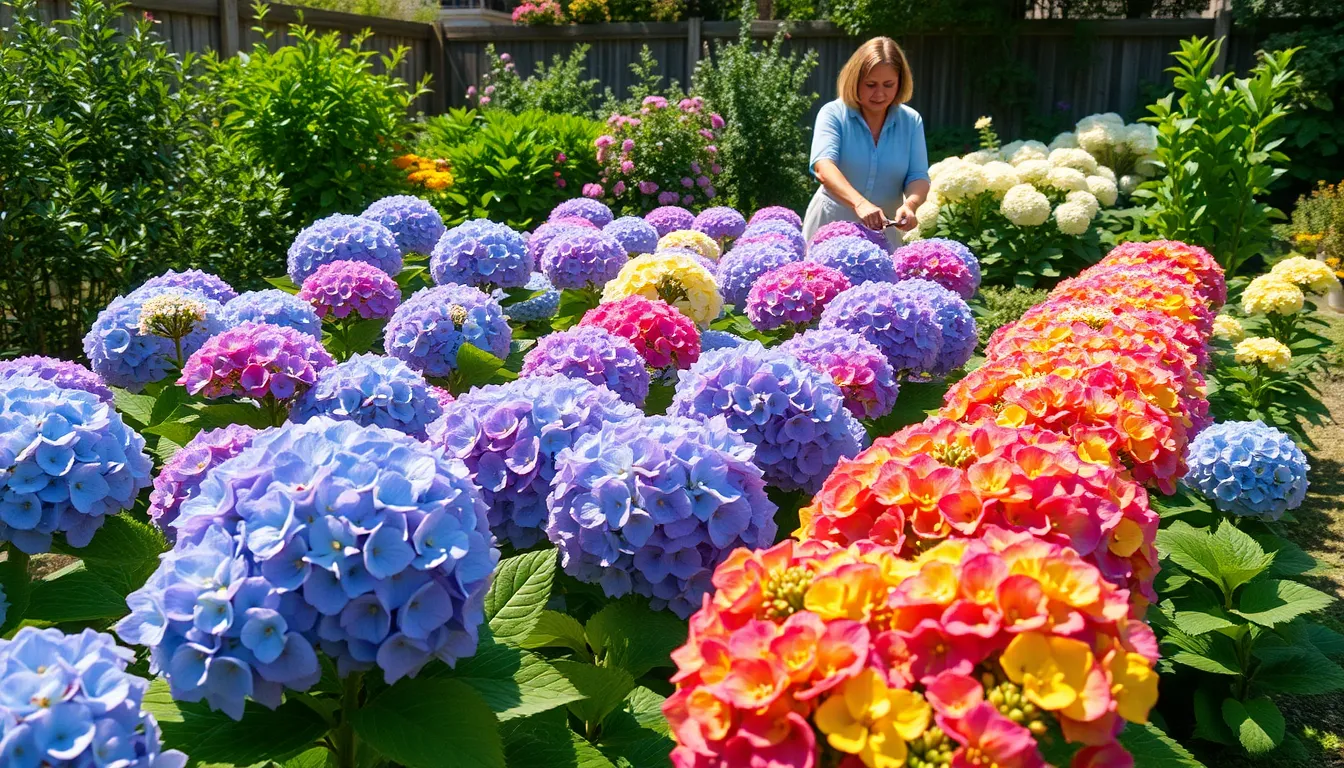
Moving beyond foundation plantings, we can create a dedicated cutting garden that provides an endless supply of beautiful hydrangea blooms for our indoor arrangements. This specialized garden design allows us to grow hydrangeas specifically for harvesting while maintaining the visual appeal of our industry.
Select Best Varieties for Fresh and Dried Arrangements
Mophead hydrangeas serve as the foundation of any cutting garden with their large, round clusters of flowers that create stunning focal points in arrangements. These varieties offer bold, spherical blooms in colors ranging from deep blues to vibrant pinks, making them perfect for both casual and formal bouquets.
Lacecap hydrangeas provide delicate, lacy flowers that add texture and movement to our arrangements. Their flat topped blooms feature tiny fertile flowers surrounded by larger sterile flowers, creating an elegant contrast that works beautifully in mixed bouquets.
Hydrangea paniculata produces long, conical flowers that excel in cut arrangements due to their sturdy stems and dramatic shape. These varieties transition from white to pink or burgundy as they mature, offering us multiple color options from a single plant throughout the growing season.
Smooth hydrangeas contribute reliable white blooms that serve as perfect neutral elements in our arrangements. Their sturdy growth habit and consistent flowering make them dependable choices for regular cutting without compromising the plant’s health.
Plan Harvest Timing for Optimal Bloom Quality
Morning harvesting ensures the best quality blooms when dew is still present on the flowers. We should cut hydrangea stems during this cool part of the day to maximize water content and extend vase life significantly.
Fresh arrangement cutting requires us to harvest when flowers are fully open but still firm to the touch. This timing provides the longest lasting blooms for our indoor displays while ensuring petals remain crisp and vibrant.
Dried arrangement preparation calls for cutting when flowers are mature and beginning to dry naturally on the plant. We can identify this stage when petals feel papery and colors have deepened, indicating the blooms are ready for air drying.
Proper cutting technique involves making clean cuts at a 45 degree angle under running water to prevent air bubbles from blocking stem uptake. We should immediately place cut stems in cool water to maintain hydration and prevent wilting during transport to our arranging area.
Develop a Container Hydrangea Display for Patios and Decks

Transforming your patio or deck into a hydrangea paradise requires strategic container planning and creative seasonal displays. Container hydrangeas offer flexibility to move plants as needed while creating stunning focal points in smaller outdoor spaces.
Choose Appropriate Pot Sizes for Different Hydrangea Types
Selecting the right container size determines your hydrangea’s growth potential and overall health. Large planters measuring at least 16 to 24 inches wide and deep accommodate most hydrangea varieties effectively.
Compact hydrangeas thrive in smaller containers since they reach only 1 to 2.5 feet tall and wide. Varieties like Invincibelle Wee White and Wee Bit Grumpy excel in patio settings without overwhelming the space.
Mid-size and full-size hydrangeas require substantially larger containers to support their extensive root systems. Consider pots with wheels to move these heavier displays easily throughout your outdoor space.
Drainage becomes critical regardless of container size to prevent root rot and maintain healthy growth. Multiple drainage holes in the bottom of each planter ensure proper water flow while protecting your investment.
Create Seasonal Container Combinations
Spring and summer combinations showcase hydrangeas alongside colorful annuals for maximum visual impact. Petunias and impatiens complement hydrangea blooms while adding vibrant colors throughout the growing season.
Fall arrangements incorporate evergreen branches, pinecones, and seasonal berries to extend your display’s appeal. These natural elements create texture while maintaining visual interest as hydrangea blooms begin to fade.
Winter displays benefit from festive decorations like seasonal lights or holiday ornaments nestled among the containers. Seasonal themes using pumpkins in autumn or winter greenery keep your patio captivating year round.
Strategic positioning takes advantage of morning sun and afternoon shade conditions that hydrangeas prefer. This placement ensures optimal growing conditions while creating an attractive backdrop for your container arrangements.
Install a Hydrangea Privacy Screen for Natural Boundaries

Privacy doesn’t have to come from cold fences or walls when hydrangeas can create beautiful natural boundaries. We’ll transform property lines into stunning seasonal displays that provide both privacy and visual appeal throughout the growing season.
Calculate Spacing Requirements for Dense Coverage
Plant hydrangeas 3 to 6 feet apart to achieve the dense coverage necessary for effective privacy screening. This spacing allows each plant to develop its full mature width while creating seamless connections between neighboring shrubs.
Bigleaf hydrangeas require 4 to 5 feet of spacing due to their broad, spreading growth habit and large foliage. Their dense branching structure fills gaps naturally when properly spaced.
Panicle hydrangeas perform best with 5 to 6 feet between plants since they can reach 8 to 12 feet in both height and width at maturity. We recommend measuring the mature spread of your chosen variety and spacing plants at two-thirds of that distance.
Consider your exact variety’s growth characteristics when calculating final spacing requirements. Fast-growing varieties like ‘Limelight’ panicle hydrangeas may need slightly wider spacing than compact varieties like ‘Little Lime’.
Combine Different Species for Extended Bloom Time
Bigleaf hydrangeas bloom in early summer, typically from June through July, providing the season’s first wave of privacy screen color. Varieties like ‘Endless Summer’ and ‘Nikko Blue’ offer reliable early season performance with their classic mophead and lacecap flowers.
Panicle hydrangeas take over in mid to late summer, blooming from July through September with their distinctive cone-shaped flower clusters. Popular varieties include ‘Grandiflora’, ‘Phantom’, and ‘Fire Light’ which maintain their structure well into fall.
Oakleaf hydrangeas bridge the gap with late spring to early summer blooms from May through June, featuring elegant white panicles that complement their distinctive lobed foliage. Their early flowering extends the overall bloom period when combined with other species.
Strategic species placement maximizes visual impact by grouping each type in clusters of 3 to 5 plants rather than alternating individual specimens. This approach creates bold seasonal statements while maintaining the privacy screen’s effectiveness year-round.
Fall interest continues as panicle hydrangeas shift from white to pink and burgundy tones while oakleaf varieties develop brilliant red and orange foliage colors that extend the privacy screen’s appeal into autumn.
Craft a Romantic Hydrangea Pathway or Walkway Design

Creating an enchanting hydrangea pathway transforms any ordinary walkway into a magical garden experience. We’ll show you how to design curved pathways and integrate lighting to maximize your hydrangeas’ romantic appeal throughout the day and evening.
Design Curved Lines for Natural Garden Flow
Curved paths encourage exploration by meandering through your garden space rather than creating straight, predictable lines. Natural flow emerges when we design pathways that gently bend around hydrangea clusters, allowing visitors to discover new vantage points and appreciate the blooms from different angles.
Group hydrangeas in strategic clusters along these curved routes to maximize their visual impact and create focal points throughout the journey. Plant arrangements work best when we position larger panicle hydrangeas at pathway curves and smaller smooth hydrangeas along straight sections to guide the eye naturally forward.
Stone or brick hardscaping elements complement hydrangea colors while defining the pathway’s edges and preventing soil erosion. Wooden benches placed at key curve points create romantic seating areas where visitors can pause and fully appreciate the surrounding hydrangea displays.
Complementary plantings enhance the curved design by adding layers of texture and extending seasonal interest beyond hydrangea bloom times. Roses, lavender, and boxwood work exceptionally well as companion plants, creating depth while maintaining the pathway’s romantic atmosphere throughout multiple seasons.
Integrate Lighting for Evening Garden Ambiance
Soft, warm lighting transforms hydrangea pathways into magical evening destinations that highlight blooms after sunset. Solar powered lights and lanterns placed discreetly among hydrangea plantings create intimate ambiance without overwhelming the natural beauty of the flowers.
Strategic accent lighting draws attention to exact hydrangea specimens by using spotlights or uplighting to illuminate the most spectacular blooms. Evening visibility improves dramatically when we position these lights to cast gentle shadows and highlight the texture differences between mophead and lacecap varieties.
Pathway safety remains essential while maintaining romantic atmosphere through low level lighting that guides footsteps without creating harsh glare. Ground level fixtures embedded along pathway edges provide necessary illumination while keeping the focus on illuminated hydrangea displays above.
Seasonal lighting adjustments accommodate changing hydrangea colors and garden conditions throughout the year, from vibrant summer blooms to dried winter flower heads that create striking silhouettes against evening backdrops.
Conclusion
We’ve explored countless ways to transform your outdoor space with hydrangeas – from romantic cottage gardens to practical privacy screens. These versatile plants offer endless possibilities whether you’re working with a small patio or expansive industry.
The key to success lies in choosing the right varieties for your exact conditions and design goals. Remember that hydrangeas thrive with morning sun and afternoon shade while requiring consistent moisture for optimal blooms.
With proper planning and care your hydrangea garden will reward you with months of stunning color and texture. Start small with one or two ideas that excite you most then expand your hydrangea paradise over time as your confidence grows.
Frequently Asked Questions
What hydrangea varieties work best for cottage gardens?
Bigleaf, panicle, oakleaf, and smooth hydrangeas create the perfect cottage garden foundation. These varieties offer different bloom times and colors, providing year-round interest. Pair them with climbing roses, lavender, delphiniums, and foxgloves for an authentic English cottage garden aesthetic with romantic appeal.
How do I create a hydrangea privacy border?
Plant taller panicle hydrangeas at the back and shorter smooth hydrangeas in front for a tiered effect. Space plants 3-6 feet apart based on mature size. Add evergreen shrubs and ornamental grasses for winter structure, and incorporate seasonal companions like asters for extended color.
Can hydrangeas thrive in shade gardens?
Yes, hydrangeas excel in shade gardens, especially with morning sun and afternoon shade. Mass plantings create dramatic impact, while container specimens offer flexibility. Pair with shade-loving perennials like hostas, astilbe, and Hakone grass for textural contrast and year-round visual interest.
Which hydrangeas require the least maintenance?
Panicle and oakleaf hydrangeas are the most low-maintenance options, offering disease resistance and reliable performance. Improved bigleaf and smooth hydrangeas also provide excellent results with minimal care. These varieties work perfectly for foundation plantings requiring little upkeep.
What’s the best way to mulch hydrangeas?
Use organic mulch like wood chips or bark to retain moisture and suppress weeds. Apply 2-3 inches around plants, keeping mulch away from stems. Refresh annually to maintain appearance and effectiveness. This creates a professional look while conserving water and reducing maintenance needs.
How do I grow hydrangeas for cutting flowers?
Choose mophead, lacecap, paniculata, and smooth varieties for best cutting results. Harvest in early morning when stems are fully hydrated. Cut stems at an angle underwater and immediately place in cool water. For drying, harvest when blooms feel papery to touch.
Can I grow hydrangeas in containers on my patio?
Absolutely! Select appropriately sized containers with drainage holes. Position for morning sun and afternoon shade. Create seasonal displays by pairing hydrangeas with colorful annuals in spring/summer and festive decorations in winter. Ensure consistent moisture and protect from extreme temperatures.
How far apart should I space hydrangeas for privacy screening?
Space hydrangeas 3-6 feet apart depending on the variety’s mature size. For dense coverage, plant closer together. Combine different species to extend bloom time and create visual impact. Cluster plantings create bold seasonal statements while providing effective natural boundaries.
How do I design a hydrangea pathway?
Create curved walkways that encourage exploration and discovery. Group hydrangeas in strategic clusters along the path for maximum impact. Use stone or brick edging to define pathways and incorporate soft lighting for evening ambiance. Add complementary plants like roses and lavender for texture.
What companion plants work best with hydrangeas?
Traditional cottage garden plants like climbing roses, lavender, delphiniums, catmint, and foxgloves complement hydrangeas beautifully. For shade areas, try hostas, astilbe, and ornamental grasses. Boxwood provides structure, while seasonal flowers like asters extend the color display throughout the year.

